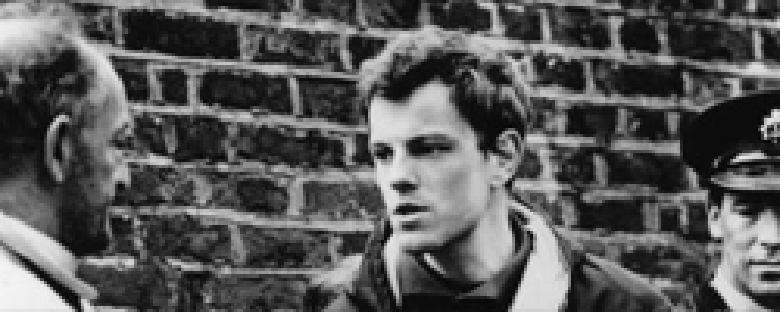Credits
Feature by: Leo Goldsmith
Posted on: 22 August 2006
Related articles:
Features: The Radical Histories of Peter Watkins
Reviews: Culloden
Reviews: The War Game
… the horror of [The War Game] was … of an entirely different quality to that which is contained in the recognizably fictional presentations of some television films. It was also different in its impact from the objective presentation of past horrors—such as scenes which might be shown in documentaries on Culloden, the Hiroshima bombings or the extermination of the Warsaw Ghetto. Such scenes, because of their fictional character or because of their historical setting, do not have the personal application … of The War Game, which conveys the sense that what it is showing could happen to people who might be watching it.
—Extract from a form letter sent by the BBC
to individuals and organizations that wrote letters seeking reasons
behind the decision not to broadcast The War Game
First, a shot of 18th-century English soldiers marching over the ridge of a hill. Then, from offscreen, a narrator itemizes a series of names, dates, and figures, detailing the particularities of the world that the film will soon enact:
Wednesday, April 16th, 1746. This is the advanced battalion of an English government army of 9,000 men. Their objective: Culloden Moor, four and a half miles southeast of the highland town of Inverness. Their purpose: the destruction of the highland Jacobite army of rebellion, a tired, ill-administered force of less than 5,000 men, who wait just beyond the top of this ridge.
The specificity of setting and detail with which Peter Watkins introduces his first film, Culloden, reassuringly attests to the presence of evidence and documentation. And with the matter-of-fact tone of the voiceover and the unity of what is being described and what is being shown (“This is the advanced battalion of an English government army of 9,000 men”), the overall facticity of what is being presented reinforces the authority of the narrator. All of these features combine to assure the spectator that what she is watching is a well-researched and reliable reconstruction of the events of the battle of Culloden Moor in 1746.
In the next instant, however, the tone shifts slightly. The narrator presents us with a cast of characters — Prince Charles Edward Stuart, Sir John MacDonald, John William O’Sullivan — the leaders of the Jacobite rebel army and the members of their respective clans. The narrator addresses these “characters” with questions (“Prince Charles, why do you fight today when some of your officers have criticized the choice of field?”), and these characters in turn respond directly to the camera (“Because God is on our side”). The voiceover has shifted from a discursive position to an interrogatory one. But interrogatory of whom? Is this in fact what Bonnie Prince Charlie would say? Is this real?
The opening moments of Culloden — with their shifts from specific reportage of factual minutiae to blatant anachronisms, and their strange intersection of dramatic, documentary, and TV news styles — are immediately followed by a scrolling onscreen text, announcing Culloden as:
An account of one of the most mishandled and brutal battles ever fought in Britain.
An account of its tragic aftermath.
An account of the men responsible for it.
And an account of the men, women and children who suffered because of it.
This emphasis on Culloden’s status as “an account” has several functions. First, it underscores the notion that the film provides many different accounts, which in turn account for many different facets of the battle and its participants. Second, it anticipates the film’s reliance on many different, pre-existing accounts for its information. (As the film’s closing credits reveal, Culloden was based on John Prebble’s 1961 history, The Battle of Culloden, which was itself based on a range of sources, including contemporary eyewitness reports and subsequent histories of the event.) Last, it calls into question the nature of all of these accounts, as well as the relation of the film’s diegesis to the remote historical events it purports to depict.
Watkins has stated that his intention in making the film for BBC television in 1964 was to
[employ] the style used in Vietnam War newsbroadcasts in order to bring a sense of familiarity to scenes from an 18th century battle, in the hope that this anachronism would also function to subvert the authority of the very genre I was using.
The strategy of the film, then, has two distinct functions: first to interrogate a remote historical event in a manner familiar to contemporary viewers (that of television war coverage), and second to interrogate the mode of contemporary news broadcasts with the responses of dramatized historical figures. What Watkins therefore initiates in Culloden is a form of dialogue between past and present.
Taken together, Culloden and The War Game, the film that followed it, represent an important first strike in a career of film and television work that radically challenges conventional modes of historical representation in the mass media. His films of historical reconstruction (such as Culloden, Edvard Munch, and La Commune (de Paris, 1871)) and, in Stuart Cunningham’s phrase, historical “pre-construction” (The War Game, Privilege, and Punishment Park) formally and thematically push the limits of documentary practice. Watkins’ first two major television documentaries function as interrogations of both past and present (and, in the case of the latter film, future) and call into question representations of historical and present realities in contemporary film and television. In Culloden, Watkins deliberately problematizes tense and perspective, destabilizing conventional notions of history and temporality on television. And in The War Game, Watkins further complicates these notions, challenging the television medium’s assumption of a secure and “live” present reality, a strategy that would inadvertently lead to the film’s eventual banning by the BBC.
We don’t do comments anymore, but you may contact us here or find us on Twitter or Facebook.



